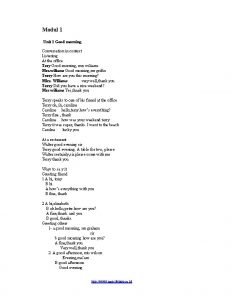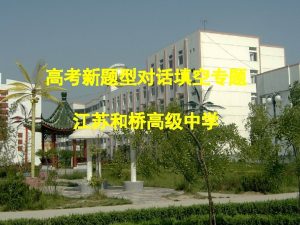Good Morning or Afternoon Today all you need































































- Slides: 63

Good Morning (or Afternoon)! • Today, all you need is a notecard from the Resource Table. • Bell Ringer: (On your notecard) • Why did people want to move out West during the late 1800 s?

Westward Expansion & The Gilded Age Lecture 1: Westward Expansion, Native Americans & The Transcontinental Railroad

Reasons for Westward Expansion: Manifest Destiny is the belief that the United States was destined to stretch across the entire North American continent from Atlantic to Pacific. This belief was a driving force behind the events associated with Westward Expansion. “And that claim is by the right of our manifest destiny to overspread and to possess the whole of the continent which Providence has given us for the development of the great experiment of liberty and federated self-government entrusted to us. ” John O’Sullivan journalist who coined the phrase “Manifest Destiny”

Reasons for Westward Expansion: Natural Resources • Gold • California Gold Rush (1849) and Klondike (Alaska) Gold Rush (1896) • Oil • Vast amounts of oil were found in Texas and other states in the West. • Farming • The Great Plains had very fertile land to farm on. • Wood • By this time, the majority of forests in the east were depleted. • The west was seen as a new source of lumber.

Reasons for Westward Expansion: Homestead Act & Over Population • The Homestead Act (1862) • Though American Indians lived in the interior Western territory (Mississippi River to Rocky Mountains), Americans saw this space as unused. • To make the land productive, Congress passed the Homestead Act – giving 160 acres to anyone who settled and cultivated (farmed) the land. • At the same time, Congress gave railroad companies tracks of land in order to encourage them to build lines connecting the East to the West, and the Great Plains were promoted as ideal for farming, due to its fertile soil. • Higher than normal rains in the 1870 s and 1880 s also encouraged settlement. • Over Population • The majority of the population lived in the Eastern part of the U. S. , which led to poor living conditions in the cities. • People wanted a new beginning. No room!

Settling the Plains • Settlers began to pour onto the Plains. These new settlers were not just land-hungry whites from the East. • Immigrants • Hundreds of thousands of people moved onto the Plains from Sweden, Norway, and Germany. • African Americans • Thousands of African Americans fled the Reconstruction South and settled mainly on the southern Plains. • One of the first waves of these African American migrants was called Exodusters, who settled primarily in Kansas.

What problems would arise as Americans began to settle the West?

Native Americans • Culture of the Great Plains Native Americans • Most were nomadic (move from place to place), and relied on the buffalo for survival. • Worshipped nature-based religions • Men’s Roles • Hunting, warfare, trading • Women’s Roles • Domestic tasks, child-raising, cooking, preparing hides

Native Americans • The spread of settlement and economic expansion came at a price, and American Indians paid it. After centuries of life on the Plains, they became an obstacle to what Americans saw as progress. • Reservations • The United States government forced Native Americans to move from their homelands to reservations (land set aside for a Native American group or groups) to make more land available for settlers and railroads. • Buffalo • Before settlers and railroads arrived, around 50 million buffalo roamed the Great Plains. • Over a period of about 40 years, settlers and railroad workers killed move the huge animals – leaving less than 1, 000 by 1900. • All of this leads to increased conflict and war on the Great Plains between the U. S. government.

War on the Plains • 1874: Gold in Black Hills, South Dakota • A gold strike in South Dakota prompted a rush of prospectors. • However, a treaty promised to preserve the land for the Lakota, as it held deep religious meaning to the tribe. • Ordered to give up their land, the Lakota revolted instead. • 1876: Battle of Little Big Horn • The Lakota chiefs refused to allow miners to dig in the Black Hills, and as a result, U. S. soldiers were sent to drive the tribe out of the area and onto reservations. • A large Lakota force was attacked by General Custer and his men, and ended in the General’s defeat– the press celebrated “Custer’s Last Stand” and the event prompted a large army response. • 1877: March of Nez Perce • Chief Joseph led the Nez Perce on a desperate march from their homeland in the Pacific Northwest towards Canada, as they were trying to avoid being put onto a reservation. • They were hunted down and captured just short of the border. • 1890: Wounded Knee • After the Sioux were moved to a reservation in North Dakota, Sitting Bull, their chief, was shot during a scuffle with officials trying to stop a ritual being performed. • The army soon arrived to collect the Sioux’s weapons, and shots rang out, killing more than 200 Sioux and 25 soldiers.

Native Americans • Many things changed the way of life of Native Americans – the movement of settlers onto their lands, the slaughter of the buffalo, attacks by the U. S. Army and the reservation policy. • Some people wanted to help the Native Americans by getting rid of the reservations and absorbing (to take in and make part of something) the Native Americans into American culture. • Assimilation • Many Native Americans were forced to assimilate (the process by which a person or persons acquire the social and psychological; trying to make someone similar to your culture) to the American culture.

The Dawes Act • The goal of the Dawes Act was to force Native Americans to accept the idea of private property and to put an end to their nomadic traditions. • The Dawes Act: • Ended tribal ownership of land. • Granted 160 acres of reservation land for farming; more for larger families. • Tried to make Native Americans farm – few succeeded and most did not want to. • Forced assimilation of Native Americans into American culture.

The Cattle Industry • During this same time period, the cattle industry also arose. • Cattle Drives • Huge herds of longhorn cattle fed on the open range of Texas, producing low beef prices there, but the demand for beef was high in growing eastern cities, resulting in overall high prices. • Texans began driving herds of cattle north to sell them at a profit in Missouri and Kansas, where they were then shipped by rail to Chicago and other cities with slaughterhouses. • Chisolm Trail • The most-used route, the Chisolm Trail, was hundreds of miles long, and stretched north from Texas, through Oklahoma, and into Kansas.

The End of the Cattle Drives • The great cattle drives lasted until the late 1880 s, until conditions changed: • Rail lines extended to Texas and refrigerated rail cars made it possible to ship meat over great distances. • Meatpacking companies moved to Texas. • More of the Plains were farmed and there was less open land for cattle to graze during a cattle drive. • Barbed wire was invented to keep cattle drives off of farmed land, and was eventually used to keep cattle restrained to a specific area. • Ultimately, the cattle industry shifted to closed-range ranching.

The Growth of Railroads • Before the Civil War, most of the railroad track in America had been built in the Eastern U. S. , specifically the Northeast. • Gold was discovered in the West, and people slowly began migrating Westward. • Travel was slow and difficult, so there was a desire to build a transcontinental railway (railroad that crosses a continent) that connected the East coast with the riches of California and the West.

Transcontinental Railroad • Railroads would have a significant impact on the economic, cultural and social development of the Western U. S. • Transcontinental Railroad • The Pacific Railway Act (1862) was established to build the Transcontinental Railroad. • It was build along the a Northern route from Omaha, Nebraska to Sacramento California. • The Central Pacific company started in Sacramento, CA. • The Union Pacific started in Omaha, NE. • They met in Promontory Point, Utah, upon the railroad’s completion in 1869.

Transcontinental Railroad • Building the Transcontinental Railroad • Civil War veterans, Irish laborers and freedmen started working westward from Omaha, NE. • Chinese workers started eastward from Sacramento, CA. • Impact of the Railroads • The Transcontinental Railroad connected the different regions of the U. S. , and railroads became the lifeline to the West. • Trains brought the settlers and everything they needed to the West, as towns sprang up. • Trains returned to the East with the products the West produced, beef, wheat, lumber and gold. • However, the growth in the West also had a negative impact: • • • Lumbering depleted forests. Sodbusters would plow the Great Plains to plant crops. Mining for gold would destroy the land. The railroads and buffalo hunters would wipe out the buffalo. Rivers and lakes would be polluted.

Good Morning (or Afternoon)! • Grab your binder, the Unit 2 Notes and the worksheet from the Resource Table. • Bell Ringer: Brainstorm. . (p. 9 of packet) • What does the word gilded mean? • What do you think the Gilded Age time period is about?

Westward Expansion & The Gilded Age Lecture 2: Industrialization, Urbanization & Immigration

The Gilded Age (1870 – 1900) • Novelist Mark Twain co-wrote a novel about the corruption that seemed rampant in Washington, D. C. – titled The Gilded Age. • This gave a name to the time period, referring to the shiny and bright surface of wealth that served as a thin cover rampant corruption and injustice beneath. • Put simply, gilded is when something is golden/beautiful on the surface, but is really cheap/worthless underneath.

Industrialization • American industrialization (economic activity characterized by the manufacturing of goods) proceeded at a rapid pace in the decades after the Civil War – referring to this time period as America’s Second Industrial Revolution. • New inventions and technologies helped fuel the economic expansion of the late 19 th century, which was caused by the Transcontinental Railroad. • The expansion of the railroad meant wealth for more than rail companies – the railroad companies needed timber, iron and steel to construct train lines, stations and locomotives, and they needed coal for power. • All of these industries grew in an effort to meet the growing system’s massive needs.

Technological Innovations • In the decades after the Civil War, steam and electricity replaced human and animal strength. • Steam engines, powered by burning coal to heat water, drove the textile mills, factories, and trains. • During the late 1800 s the center of coal mining was in the Appalachian Mountains of western Pennsylvania.

Technological Innovations • Bessemer Process • The process was patented by Henry Bessemer in 1855. • The Bessemer Process made the production of steel easier and more economical – improving the production of steel from 5 tons taking an entire day to produce to the production of 5 tons only taking 15 minutes. (mass production) • This new steel was used to lay more miles of railroad track, to build the world’s 1 st skyscrapers, and to make better machinery.

Technological Innovations • Oil • America’s first oil well was drilled in Titusville, Pennsylvania in 1859. • At first, oil was just used as a lubricant, but later it was refined into kerosene for lighting. • It wasn’t until the internal combustion engine and the development of the car that the demand for oil skyrocketed. • New sources of energy and transportation technologies have improved our mobility and our production capabilities.

Technological Innovations • The use of electricity was another of the era’s most significant developments. • Telegraph • Electricity was first used as a means of communication with the telegraph. • The telegraph dramatically changed the speed at which we communicated over great distances and made the Pony Express obsolete. • Alexander Graham Bell would later perfect the telephone in 1876. • Thomas Edison would also use electricity to produce amazing results, as he designed a way to get electricity into homes and businesses. • He was also able to create: • Motion pictures (entertainment); • The light bulb (world went 24/7); and • The phonograph (which later gave way to other forms of recordings).

Other Technological Innovations • This was a time period of many inventions that improved the lifestyle and standard of living of many Americans. • Typewriter – created by Christopher Sholes; made businesses more productive and helped improve communications. Eventually led to computer keyboards. (1867) • First Successful Manned Flight – flown by the Wright Brothers. Although their first flight lasted only seconds, it opened way for air travel at a dramatically increased speed and distance travelled. (1903) • Sewing Machine– invented by Elias Howe; clothing could be made cheaper, faster, and now at home. (1846) • Passenger Elevators – created by Elisha Otis; the new technique of making steel allowed for skyscrapers, and this created a need for elevators to carry people between floors. (1852)

Development of a National Market • A new truly national market began to emerge as railroads, canals, the telegraph and telephone linked the country together. • National producers could now ship their goods cheaper and would dominate sales in the West. • New methods of marketing and advertising gave manufacturers the ability to expand across the nation. • It is during this time period that we see the emergence of catalogs, such as the Sear’s Catalog, which became “wish lists. ”

Impact of Population Growth • During this time, the U. S. experienced a rapid population growth, as the population jumped from 2 million to 76 million in just 50 years. As a result, cities were crowded. • A high birth rate and a constant stream of immigrants created a rising demand for goods and the growing population was a steady supply of cheap labor. • This population growth favored business expansion.

Urbanization • Accelerating industrialization contributed to the process of urbanization – the movement of people from the countryside to towns and cities. • An important result of industrialization was the rapid expansion of American cities. • In 1865, only two U. S. cities actually had populations of more than 500, 000 – New York and Philadelphia. • By 1900, that number had risen to six, and three of those had populations of more than 1 million. • Factors contributing to the rapid urban growth: • New farm machinery reduced the number of farm jobs. • The rise of industry had created many new job opportunities in the cities. • Americans were attracted to the cities their cultural opportunities, popular entertainment and rich variety. • The urban growth was further fueled by unprecedented levels of immigration.

Immigration • In the late 19 th century, European immigrants flooded American cities in search of work and places to live – in such large numbers they sometimes came to outnumber the native-born Americans. • Immigrants have always come the U. S. for a variety of reason, which may be divided into “push” and ”pull” factors.

“New Immigrants” • Patterns of immigration changed in the 1880 s, as the construction of railroads across Europe and the appearance of large ocean-going steamships made the voyage to America more accessible to many Europeans. • Most of these “New Immigrants” came from Southern and Eastern Europe. • They were often Catholic, Jewish or Orthodox Christian rather than Protestant, and spoke no English.

The Immigrant Experience • Immigrants in the late 19 th century usually faced great hardships, beginning with their passage to America. • They traveled in an open room below deck, with their life’s belongings in a single bag. • On a clear day, they assembled on the ship’s deck for fresh air and sunlight. • Most first arrived in New York City, where they were processed at the government center on Ellis Island. • Those with tuberculosis or other diseases were sent back. • Initial Hardships • Most settled in cities, were usually poor, dressed differently from other Americans and were unfamiliar with American customs. • They lived in crowded tenement buildings and worked at unskilled jobs for long hours at low pay. • They faced hostility and discrimination from native-born Americans and even other immigrant groups. • Ethnic Ghettos • To cope with their problems, immigrants usually settled with relatives and others of the same nationality in ethnic neighborhoods known as ghettos. (ex. China Town or Little Italy)

Americanization • While some adult immigrants attended night school to learn English, most were too busy working and caring for their families. • It was left to their children to learn English and become Americanized (Americanization) – learning to dress, speak and act like other Americans. • These immigrant children eventually became assimilated – similar to other Americans. • As a result, America was seen as a melting pot, in which immigrants were melted down and reshaped. • As this Americanization and assimilation occurred, it was often accompanied by conflict, as parents wanted to hold on to traditions. (ex. arranged marriages)

The Rise of Nativism & Immigration Restrictions • The Rise of Nativism • As the flood of immigrants grew, hostility towards immigration also mounted. • Nativists, or those born or native to the U. S. , wanted to restrict immigration, and believed that people of other races, religions and nationalities were inferior and that the “New Immigrants” were especially inferior. • They believed immigrants could never be fully absorbed into American society and that their acceptance of low wages would steal jobs from other Americans. • Early Restrictions on Immigration: The Chinese Exclusion Act (1882) • It was the first federal law to restrict immigration into the U. S. • It reflected American prejudices at the time against the Chinese, who were blamed for unemployment and decreased wages in California. • The law temporarily banned the immigration of Chinese workers, and required those already living in the U. S. to obtain a special certificate before leaving the U. S. if they planned to reenter and courts were denied the ability to grant citizenship to these residents.

The Problems Created by Growing Cities • Urbanization led to physical changes in the landscape, and American cities mushroomed so quickly that municipal (city) authorities were often unable to deal adequately with all of the problems. • Inadequate Public Services • Cities lacked the ability to deliver increased public services – hospitals, police forces, schools, fire departments, street cleaning, and waste collection. • Transportation • Horse-drawn coaches and later electric trolleys were needed to transport workers to their jobs. • To eliminate the pollution created by coaches and trolleys, New York City built a subway in 1900, and, by 1930, it was the world’s largest subway system. • Overcrowding • Families were crowded into tenements (small apartment buildings), which lacked daylight, heat, fresh air and adequate plumbing. • Social Tensions • In cities, rich people lived next door to the poor. Seeing the luxuries of the wealthy distressed poor people and increased social tensions and crime.

Political Machines • City governments were often run by corrupt political machines, and the leaders of these machines were known as political bosses. • These machines often provided jobs and other services to immigrants and the poor in exchange for their votes. • The power of the political boss depended upon his ability to dominate voting and to control the agencies of municipal government. • The machines also often had the support of other local business leaders. • By controlling elected officials in local government, political bosses were able to hand out government jobs to reward loyal workers. • The bosses then used their control of city hall to make illegal profits on city contracts or by collecting bribes. • Boss Tweed of Tammany Hall in New York City • He controlled thousands of city workers and influenced the operation of schools, hospitals and other city-run services. • Tweed benefitted from the support of Irish immigrants, and he controlled or bribed lawmakers to pass laws favorable to his interests. • He often overpaid himself on construction projects and land sales – stealing millions from the city.

Immigration & Urbanization Worksheet • Using your notes from today and the information on the worksheet, complete the Immigration and Urbanization Worksheet.

Good Morning (or Afternoon)! • Please, do not get d-hall today. Be in Bell Ringer Mode when the Bell Rings. • Grab your binder and a Robber Barons v. Captains of Industry worksheet. • Bell Ringer: • Grab your worksheet from yesterday. • For the bell ringer, we will discuss the answers.

Westward Expansion & The Gilded Age Lecture 3: Big Business

New Types of Business Organizations • Before the Civil War, most American businesses were owned by individuals or by a group of partners. • After the war, corporations (a company chartered by a state and recognized in law as a separate “person”) became more common. • Corporations issue and sell ‘stock’ or shares of a company. • A shareholder is a partial owner, and they receive a share of a corporations profits based on the amount of stock they own. • Shareholders were responsible only for the shares they own, not for losses and are protected from lawsuits. • Corporations allowed for people to pool their money to raise the huge sums needed to build railroads, factories, steel mill, etc. • Big business is born!

The Free Enterprise System • People have unlimited wants, but we have limited resources to satisfy these wants. • Businesses use their resources to compete with each other to satisfy these consumer desires. • Every society must answer three basic economic questions to determine how to use its resources to satisfy these wants: 1. What should be produced? 2. How should it be produced? 3. Who gets what is produced? • The U. S. has the Free Enterprise System to answer these questions.

The Free Enterprise System • The success of America’s industrialization was based on its free enterprise system. • In a Free Enterprise System, people have the freedom to make their own choices in what to buy, where to work, and what to make. • People are free to use their money and time to start a business in hopes of making a profit. (Producers) • People are free to choose the type of product they wish to buy and how much they’ll pay. (Consumers) • Laissez-Faire – government keeps their hands off of the economy.

Entrepreneurs • An entrepreneur is a person (or small group) who starts a business in the hope of making a profit. • In the 1870 s, entrepreneurs began to exercise a dominant influence on American economic life. • Efficient large-scale production allowed them to sell goods at lower prices and Competition forced them to continually improve the quality. • Many of these entrepreneurs made huge fortunes.

Robber Barons v. Captains of Industry • Many of the more successful entrepreneurs became known as Captains of Industry, as they forged the modern industrial economy. • Critics of these successful entrepreneurs referred to them as Robber Barons, due to their ruthless tactics they used to destroy competition and keep workers wages low. • Some of the best known were:

Robber Barons v. Captains of Industry • Robber Barons were often accused of: • unfair business practices, • being above the law, • abusing labor with low wages and long hours, • having too much influence on the government, • simply not caring about the American public, and • being just plain greedy.

Andrew Carnegie • Carnegie started penniless, but he made his fortune in steel mills in the Pittsburgh, PA area – founding the Carnegie Steel Corporation in 1892. • He undercut the competition, bought his own iron ore fields, coal mines and ships, so he could control all phases of steel production. • He crushed attempts to form labor unions, paid low wages, and forced laborers to work 12 hour days. • The labor strike on Carnegie’s Homestead Steel Mill would be one of the eras most violent.

John D. Rockefeller • Rockefeller started out poor, but made his fortune in oil in Ohio. • Kerosene, for lighting, made him millions, and later, the gasoline industry would make him even richer. • He used ruthless tactics to drive his competition out of business, then he would buy them out. For example, he forced railroad companies to give him a special, secret rate for shipping his oil, while they charged his competitors higher prices. • His Standard Oil Co. became a trust, with him owning most of the shares. • Later, it would be a monopoly (a company having complete control over the supply of a product or service) as he controlled 90% of all oil refined.

Philanthropy • Carnegie and Rockefeller both made millions at the expense of the American pubic. • They paid low wages and demanded long hours of work. • As businessmen they didn’t believe in charity, their belief was: “help those who help themselves. ” • Later, both would lead the rich in philanthropy, as they gave away millions of their dollars to the public. (Carnegie gave $350 million. ) • They built libraries', museums, scholarships, and universities.

The Gilded Age • The time when these Captains of Industry ruled America became known as the Gilded Age. • They amassed fabulous wealth and lavishly spent it while the majority of Americans were poor. • These ‘robber barons’ were glorified and vilified. • Some, like Carnegie and Rockefeller, became the richest men in the world.

Good Morning (or Afternoon)! • Grab your binder and begin working on the Bell Ringer. • Bell Ringer: • Annotate the political cartoon. • What is the main idea of the political cartoon?

Westward Expansion & The Gilded Age Lecture 4: Labor Unions

Pros and Cons of Big Business • Large business is more efficient, which leads to lower prices. • Hire large numbers of workers. • Produce goods in large quantities. • Have the resources for expensive research and to invent new items. • Unfair competitive advantage against smaller businesses. • Often exploited workers. • Often unconcerned about pollution they may cause. • Have an unfair influence on government rules that affect them.

The Conditions of Labor • As America continued on its path of astonishing economic growth, there was increasing exploitation of industrial workers. • The average workday was long by today’s standards: 10 -14 hour days, 6 days a week with low wages ranging from $3 to $12 a week. • Employers often hired immigrants, as they were will to work for far less, along with women and children. • Conditions were extremely dangerous within the factories, with no safe guards. • Children were often used to move, clean or fix large machines since they were small enough to fit between the parts. This led to countless injuries and deaths. • Workers could be fired at any time for any reason – resulting in no job security within the workforce.

Factory Working Conditions • As factories and work places grew larger, workers lost all personal contact with their employers. • As industrialists sought to achieve greater speed and efficiency, each worker became nothing more than a human cog in a vast machine. • Work became less skilled, more repetitive, monotonous and boring. • Industrial working conditions in the late 19 th century were also often extremely hazardous. • Safeguards around machinery were inadequate and thousands of workers were injured or killed in industrial accidents each year.

The Rise of Unions • As big business grew, workers lost all bargaining power with their employers. • Most work was unskilled and workers could easily be replaced. • Some workers began to form unions in order to act as a group, not as individuals. • Unions organized strikes and other forms of protest to get better working conditions. • Some owners refused to allow unions, and would close a factory rather than negotiate with the unions.

Major Unions • The Knights of Labor (formed in 1869) created a single national union by joining together skilled and unskilled workers. • They demanded an 8 -hour work day, higher wages, and safety codes in factories. • They supported equal pay for women and opposed child labor. • They also opposed immigration, as they saw immigrants as competition for their jobs. • But, skilled workers resented being in the same union as unskilled labor, and the Union soon fell apart after loosing a series of major strikes. • The American Federation of Labor (AFL) was founded in 1881 by Samuel Gompers, who hoped to create a union that united workers with similar economic interests. • Unlike the Knights of Labor, the AFL consisted of separate unions of skilled workers who joined together into a federation. • Gompers limited his goals to winning economic improvements for workers (such as higher wages), but fought hard to improve job security by seeking closed shops (places where only union members could be hired). • However, the AFL ultimately failed as in excluded unskilled workers, who made up the bulk of the workforce.

Good Morning (or Afternoon)! • Grab your binder and begin working on the Bell Ringer. • Bell Ringer:

Westward Expansion & The Gilded Age Lecture 5: Labor Strikes, the Government & Laws

Government Attitudes Towards Unions • Government leaders were critical towards unions, as they favored business over labor. • More than 20, 000 strikes occurred between 1880 and 1900, and some were violent. • Government officials feared union strikes would have a negative impact on the USA’s economy.

Union Strikes and the Public • Public opinion also favored the idea of laissez-faire policies (little government involvement). • Most believed that businesses had the right to hire and fire whoever they wanted, and many feared unions would ultimately lead to higher prices. • The Haymarket Affair of 1886 emphasized the violence that had become associated with union strikes. • Labor leaders were blamed when a bomb exploded during a demonstration of striking workers at Haymarket Square in Chicago. • 7 policemen were killed and 67 others were injured. • Other infamous strikes included the Pullman Strike and Homestead Steel Strike.

Laws Against Big Business • At first, the government did little to regulate big business. • Government and business leaders believed in laissez-faire – theory that government should not interfere in the operations of the free market. • However, the government did have some involvement in business, such as patent laws, enforcing contracts, laws protecting property, and tariffs to help American manufacturers. • Some of the anti-competitive practices of big business soon became so oblivious that reformers started calling for government intervention to remedy the problems.

Laws Against Anti-Competitive Practices Interstate Commerce Act (1887) • Railroads often charged small farmers more to ship goods than large companies. • Some states passed laws to stop this, but the Supreme Court ruled these laws were unconstitutional, and that only Congress had the power to regulate interstate commerce. • In response, Congress finally passed the Interstate Commerce Act – prohibitting unfair practices by the railroads. • The Interstate Commerce Commission was created to enforce these laws. • This was the first time Congress had regulated big business.

Laws Against Anti-Competitive Practices Sherman Anti-Trust Act (1890) • Federal law aimed at stopping monopolies (total control of a type of industry by one person or company) and trusts (way of organizing a number of businesses so that a few people, called trustees, control them) from engaging in unfair practices that prevented fair competitive advantages. • The act marked a significant change in the attitude of government about the abuses of big business. • Standard Oil was the first monopoly the government attempted to stop.
 Cómo se dice buenas tardes
Cómo se dice buenas tardes Good morning i am fine
Good morning i am fine Good morning hi
Good morning hi Good afternoon teacher
Good afternoon teacher Good morning class
Good morning class Good afternoon class
Good afternoon class Again
Again Goodmorning students
Goodmorning students Good morning students how are you today
Good morning students how are you today Good morning students how are you today
Good morning students how are you today Teacher good morning students
Teacher good morning students Difference between formal and informal communication
Difference between formal and informal communication Nothing compares to your embrace
Nothing compares to your embrace Let's be good friends you and i
Let's be good friends you and i Good morning afternoon evening
Good morning afternoon evening Wish strength
Wish strength Good morning campers today's challenge is simple
Good morning campers today's challenge is simple Snowman mad libs
Snowman mad libs Ask say tell
Ask say tell Good evening conversation
Good evening conversation Good morning campers today's challenge is simple
Good morning campers today's challenge is simple Good morning challenge
Good morning challenge Good morning responses
Good morning responses Hello nice to meet you here
Hello nice to meet you here Toiab
Toiab Morning i see you in the sunrise every morning
Morning i see you in the sunrise every morning You are good and your love endures forever
You are good and your love endures forever Good morning gentlemen or gentleman
Good morning gentlemen or gentleman Good charlotte
Good charlotte Good morning good lookin
Good morning good lookin Good evening ladies and gentlemen. we are now
Good evening ladies and gentlemen. we are now Good morning one and all
Good morning one and all Encoder and decoder applications
Encoder and decoder applications Love is not all: it is not meat nor drink
Love is not all: it is not meat nor drink All i need is the air that i breathe and to love you abba
All i need is the air that i breathe and to love you abba Money is all you need
Money is all you need Hello song
Hello song Receptionist good morning
Receptionist good morning Good morning everybody how are you
Good morning everybody how are you Good morning gentlemen. of you is first in line
Good morning gentlemen. of you is first in line Thank you french
Thank you french Doctor good morning what can i do for you
Doctor good morning what can i do for you Shop assistant good afternoon
Shop assistant good afternoon Eko supriyanto hadi
Eko supriyanto hadi Morning jobs
Morning jobs Customer shop assistant dialogue
Customer shop assistant dialogue Good morning hello and how are you
Good morning hello and how are you Good thoughts, good words, good deeds
Good thoughts, good words, good deeds Today meeting or today's meeting
Today meeting or today's meeting In todays class
In todays class Today meeting or today's meeting
Today meeting or today's meeting Fingerprint galton details
Fingerprint galton details Today's lesson or today lesson
Today's lesson or today lesson Today's lesson or today lesson
Today's lesson or today lesson Punctuating split speech
Punctuating split speech How you use ict today and how you will use it tomorrow
How you use ict today and how you will use it tomorrow Name 3 points
Name 3 points Dear ladies and gentlemen
Dear ladies and gentlemen That's all for my presentation
That's all for my presentation Good afternoon teacher
Good afternoon teacher Good morning, ___ and gentlemen.
Good morning, ___ and gentlemen. Good afternoon assistant
Good afternoon assistant Good afternoon stay safe
Good afternoon stay safe Good afternoon stay safe and healthy
Good afternoon stay safe and healthy



















































































